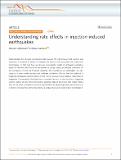Understanding rate effects in injection-induced earthquakes
Author(s)
Alghannam, Maryam; Juanes, Ruben
DownloadPublished version (681.1Kb)
Publisher with Creative Commons License
Publisher with Creative Commons License
Creative Commons Attribution
Terms of use
Metadata
Show full item recordAbstract
Understanding the physical mechanisms that underpin the link between fluid injection and seismicity is essential in efforts to mitigate the seismic risk associated with subsurface technologies. To that end, here we develop a poroelastic model of earthquake nucleation based on rate-and-state friction in the manner of spring–sliders, and analyze conditions for the emergence of stick-slip frictional instability—the mechanism for earthquakes—by carrying out a linear stability analysis and nonlinear simulations. We find that the likelihood of triggering earthquakes depends largely on the rate of increase in pore pressure rather than its magnitude. Consequently, fluid injection at constant rate acts in the direction of triggering seismic rupture at early times followed by aseismic creep at late times. Our model implies that, for the same cumulative volume of injected fluid, an abrupt high-rate injection protocol is likely to increase the seismic risk whereas a gradual step-up protocol is likely to decrease it.
Date issued
2020-06Department
Massachusetts Institute of Technology. Department of Civil and Environmental EngineeringJournal
Nature Communications
Publisher
Springer Science and Business Media LLC
Citation
Alghannam, Maryam and Ruben Juanes. "Understanding rate effects in injection-induced earthquakes." Nature Communications 11, 1 (June 2020): 3053. © 2020 The Author(s)
Version: Final published version
ISSN
2041-1723